Galls or cecidia are a kind of swelling growth on the external tissues of plants. Plant galls are abnormal outgrowths of plant tissues, similar to benign tumors or warts in animals. They can be caused by various parasites, from viruses, fungi and bacteria, to other plants, insects and mites. Plant galls are often highly organized structures so that the cause of the gall can often be determined without the actual agent being identified. This applies particularly to insect and mite plant galls. The study of plant galls is known as cecidology.
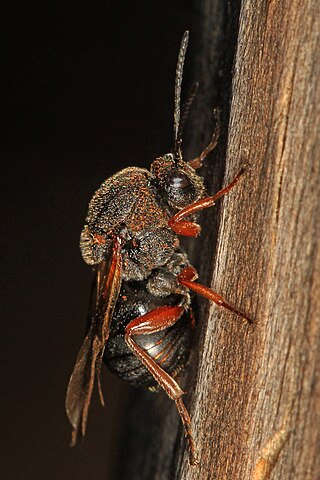
Gall wasps, also traditionally calledgallflies, are hymenopterans of the family Cynipidae in the wasp superfamily Cynipoidea. Their common name comes from the galls they induce on plants for larval development. About 1,300 species of this generally very small creature are known worldwide, with about 360 species of 36 different genera in Europe and some 800 species in North America.

Neuroterus is a genus of gall wasps that induce galls on oaks in which the wasp larvae live and feed. Some species produce galls that fall off the host plant and 'jump' along the ground due to the movement of the larvae within.

Cynips is a genus of gall wasps in the tribe Cynipini, the oak gall wasps. One of the best known is the common oak gall wasp, which induces characteristic spherical galls about two centimeters wide on the undersides of oak leaves.

Cynips quercusfolii, also known as the cherry gall wasp, is a gall wasp species in the genus Cynips and family Cynipidae. The species is important for the production of commercial nutgall formed on Quercus lusitanica . Galls are located on the underside of leaves, with the majority of galls being on the second and third veins from the petiole of the leaf.

Andricus grossulariae is a gall wasp species inducing agamic acorn cup galls on oak tree acorn cups and sexual phase galls on catkins. Synonyms include Andricus fructuum, Andricus gemellus, Andricus intermedius, Andricus mayri and Cynips panteli.

Andricus dimorphus, also called the clustered midrib gall wasp, is a species of oak gall wasp in the family Cynipidae. Galls in which the larvae live and feed are formed in clusters along the midrib on the underside of oak leaves.

Cynips douglasii, the spined turbaned gall wasp, is a species of gall wasp in the family Cynipidae. It induces galls in valley oaks, blue oak, and scrub oaks. These galls are noted for their spines and can be white, purple, or pink. They can be up to 15 mm high and 10 mm wide. For the unisexual generation, female adult wasps emerge from the galls in January and February. The smaller bisexual generation emerges in spring and produces rounder galls.
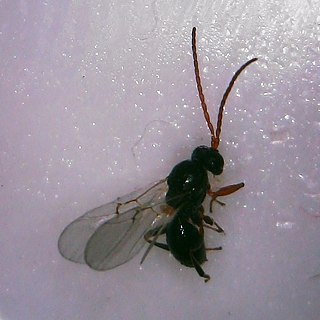
Andricus quercuspetiolicola, also called the oak petiole gall wasp, is a species of oak gall wasp in the family Cynipidae. Galls in which the larvae live and feed are formed along the midrib or petiole of white oak leaves.

Cynips quercusechinus, the urchin gall wasp, is a species of gall wasp in the family Cynipidae. It induces galls in the leaves and leaf buds of blue oak and scrub oak. Like other oak gall wasps, it has two generations: a bisexual generation, and a parthenogenic female generation. In spring, the hatching bisexual generation produces hollow green galls in leaf buds. In summer, the unisexual generation induces its galls, which are red or pink and resemble sea urchins, on the undersides of leaves. These galls are about 10 millimetres (0.39 in) in diameter. The galls fall with the leaves in autumn, and the larvae inside of them emerge as adults in the spring and lay their eggs.
Antron is a genus of gall wasps in the tribe Cynipini, the oak gall wasps. Some authors have included it within the genus Cynips but it was recently resurrected. The genus was established by Alfred Kinsey in 1930.
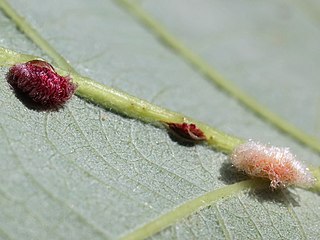
Druon ignotum is a species of gall wasp in the family Cynipidae.

Acraspis guadaloupensis is a relatively uncommon species of cynipid wasp that produces galls on intermediate oaks. The intermediate oak disc wasp was first described in 1911 and has been moved between genera more than once. Distribution is limited to California in North America. The flattened galls appear on leaves of Quercus chrysolepis, the canyon live oak.
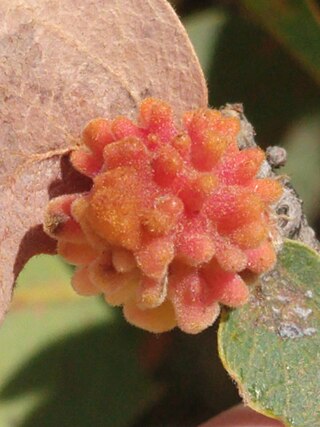
Burnettweldia corallina, formerly Disholcaspis corallina, the coral gall wasp, is a species of hymenopteran that induces galls on blue oaks in California in North America. The wasp oviposits at the base of leaf petioles. The detachable galls start out a mottled red-orange-yellow and over time darken to a deep brown and become brittle. This gall superficially resembles the oak galls induced by Besbicus heldae and Cynips quercusechinus.

Besbicus is a genus of gall-inducing cynipid wasp found in North America. Several species now classed as Besbicus were formerly considered to be a part of the genus Cynips. Besbicus was originally described as a subgenus by Alfred Kinsey in 1929. Circa 2010, one group of entomologists noted that it was "possible that the nearctic genera Antron and Besbicus were erroneously synonymized to Cynips".
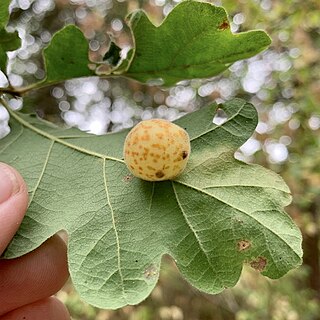
Besbicus mirabilis, formerly Cynips mirabilis, also known as the speckled gall wasp, is a common species of cynipid wasp that produces galls on oak trees in North America. This wasp oviposits on the midrib of the underside of Oregon oak leaves. One to three detachable galls per leaf have been observed. The larval chamber is at the center of the gall, connected to the husk by slender, radiating fibers. The second generation of this wasp induces bud galls. The galls may be parasitized by moth larva or eaten by earwigs or other enterprising arthropods before the larva complete their development. This wasp is present on the Pacific coast of North America from British Columbia to northern California.

Besbicus conspicuus, formerly Cynips conspicuus, also known as the fuzzy gall wasp, is a common species of cynipid wasp that induces globular stem galls on white oak trees on the west coast of North America. This gall is solid but for the central larval chamber. After the wasp emerges, beetles sometimes chew through the husk to consume the tissue inside. Besbicus conspicuus galls are sometimes mistaken for Disholcaspis washingtonensis galls. This wasp is found west of the Sierra Nevada range in California in North America.
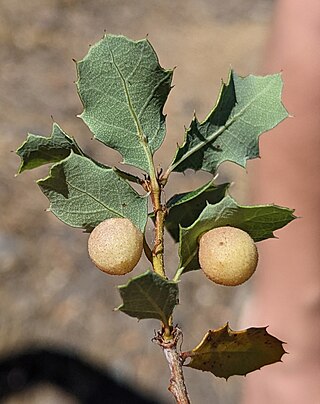
Besbicus maculosus, formerly Andricus maculosus and Cynips maculosa, also known as the pear gall wasp, is an uncommon species of cynipid wasp that induces galls on oak trees on the west coast of North America. The wasp oviposits on leather oak and scrub oak leaves. Fresh galls are green. This wasp has been observed in California.
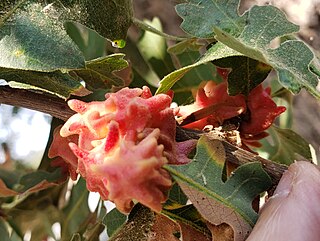
Besbicus heldae, formerly Cynips heldae, also known as the thorny gall wasp or thorn gall wasp, is an uncommon species of cynipid wasp that induces bud galls on Oregon oak and valley oak trees on the west coast of North America. Fresh gall are rose pink, measure 6–16 mm in diameter, and have a "mealy-granular" surface and possibly overlapping, disorderly looking "spikes". Galls are detachable and turn brown as they age. This gall superficially resembles the galls induced by Burnettweldia corallina or Cynips quercusechinus.
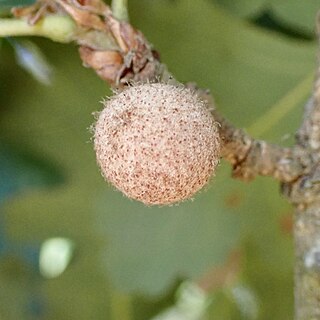
Burnettweldia washingtonensis, formerly Disholcaspis washingtonensis, the fuzzy gall wasp, is a species of hymenopteran that induces stem galls on white oaks on the Pacific coast of North America. The detachable galls have a little stem or neck, are gray or beige and fuzzy, and measure about 8–10 mm in diameter. The larval chamber is located at the center of the ball, the interior of which is otherwise chocolate brown. Older galls may appear pitted. The locally common galls induced by this wasp are sometimes mistaken for the galls induced by Besbicus conspicuus.

















